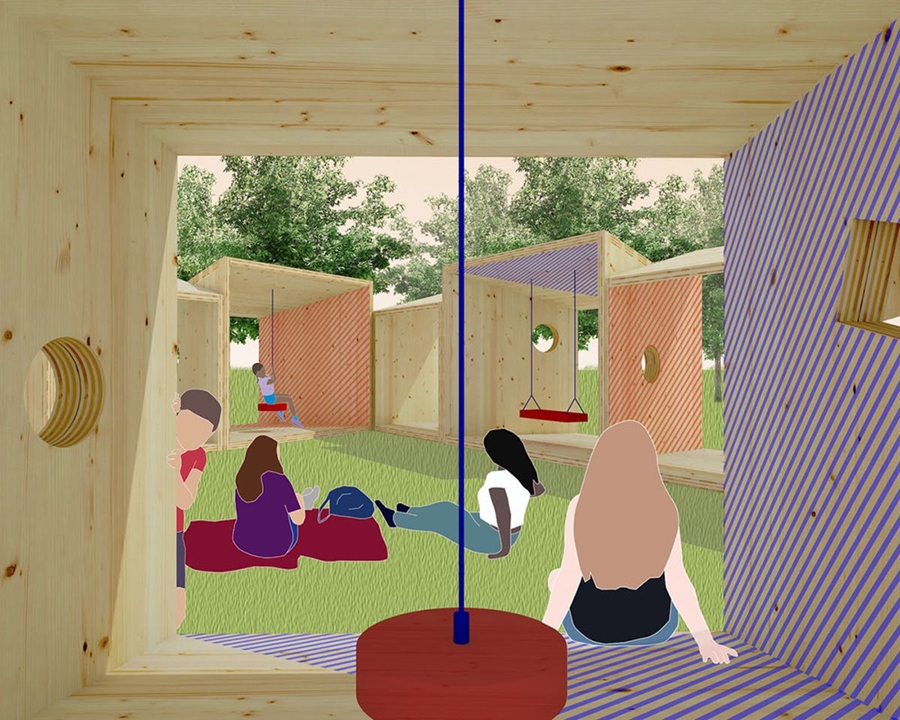
FAYETTEVILLE, Ark. – Cross-laminated timber panels left over from constructing the Stadium Drive Residence Halls will soon get a new life. A competition-winning design by two Fay Jones School of Architecture and Design faculty members will transform them into a pavilion of swing structures.
Jessica Colangelo, assistant professor of architecture, and Charles Sharpless, lecturer and project architect at the University of Arkansas Community Design Center, won the 2019 City of Dreams Pavilion competition with their concept. They developed the design for the project working through their professional firm, Somewhere Studio. Both are new to the University of Arkansas, joining the faculty in fall 2018. The Community Design Center is an outreach program of the Fay Jones School.
Their design, Salvage Swings, is made up of 12 identical swing structures put together to form a pavilion. Each one consists of salvaged cross-laminated timber panels, or CLT, and will have a swing. Every swing structure has a circle cut out of the side for a window, and that circle is used as the seat of the swing. A prototype of their design is located on the south terrace of Vol Walker Hall.
Their design will be built this summer on Roosevelt Island in New York City, and it will open to the public from June through August. Colangelo said they're planning to add solar-powered LED strip lights to the window openings when the pavilion is constructed.
"They'll project light to make the whole box glow," she said.
The City of Dreams Pavilion competition is hosted by the non-profit FIGMENT, the Emerging New York Architects Committee of the American Institute of Architects New York Chapter, and the Structural Engineers Association of New York. The international competition is open to anyone — not just architects or designers — and entrants are asked to build a pavilion that showcases sustainable building practices.
Part of the sustainability consideration is thinking about what happens to the pavilion after the summer ends. Colangelo said the Salvage Swings were designed so they can be taken apart and reassembled elsewhere, whether that means all together as the 12-structure pavilion or individually, as each one is structurally independent.
The reusability of the designers' proposal stood out to the competition's four-person jury, whose members said they appreciate "the pavilion's clear afterlife as disassembled, reusable modules, and enjoy the details of the cut-out swing set."
"The jury enjoys the exploration of play in 'Salvage Swings,' and the constructed vantage points into vignettes of other park users," the jury comments stated. "We think the options of multiple arrangements of modules in various installations is convincing."
Colangelo said they've been interested in the competition for a while, and they've seen some innovative designs over the years. As the competition approached last year, they looked into it in earnest.
Colangelo and Sharpless started designing the project in September, and they tossed around several different ideas before landing on using CLT panels.
"Since we had recently started at the University of Arkansas last semester, we heard about the Stadium Drive Residence Halls project," Colangelo said. "We heard that there was an excess of these CLT panels from the residence halls, which was basically the result of the shipping process."
Binderholz GmbH, the Austrian company that makes the CLT panels, put an extra three-ply CLT panel at the bottom of the shipping container to protect the panels that would actually be used in the buildings from getting scratched or damaged.
After deciding on the design, Colangelo and Sharpless submitted their proposal in October. In November, they found out they were one of five teams whose proposals were shortlisted for the competition.
A requirement of the second stage of the competition was proving their concept would work. So, they built the prototype swing structure currently installed at the school.
TThey hired two students as research assistants: Shiloh Bemis, a second-year honors architecture student, and Bryan Murren, a fourth-year architecture student.
Each swing structure is made up of eight panels that have to be cut out on a computer numerical-control mill. Along with members of the Fay Jones School's fabrication lab, the students helped mill the panels.
Although the swing structures can be constructed with as few as two people, Colangelo and Sharpless worked with the students and members of the U of A Community Design Center and the Fabrication Labs to assemble the prototype in December.
They learned in February that they won the contest, which means they're now taking the next steps to finalize the design plans and get everything ready to assemble in May. One of the biggest steps is raising money to buy additional supplies and ship everything to New York.
"Part of winning the competition means you also have to fundraise for the project," Colangelo said.
They received a $7,000 FIGMENT grant for winning the competition, and they are raising an additional $15,000 through a Kickstarter campaign that runs through March 23.
After the team fabricates the panels at the school, they will flat pack them and ship them to New York to begin the assembly process, Colangelo said.
The competition sponsors will help gather volunteers to assemble the swing structures on site over a few weekends in May, and then the installation will officially open June 1. Bemis is helping them with fabrication, and he will likely join them in New York City to lead some of the volunteer teams, Colangelo said.
After the summer, the pavilion will be disassembled and the swing structures will head elsewhere. Colangelo said they're already in talks with a few different organizations that are interested in bringing the swings to their grounds.
Contacts
Shawnya Lee Meyers, digital media specialist
Fay Jones School of Architecture and Design
479-575-4744, slmeyers@uark.edu
Michelle Parks, director of communications
Fay Jones School of Architecture and Design
479-575-4704, mparks17@uark.edu